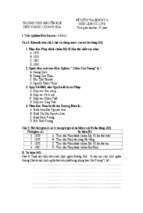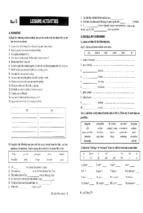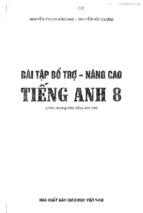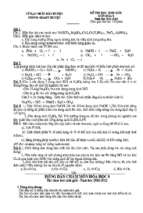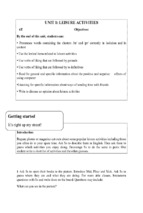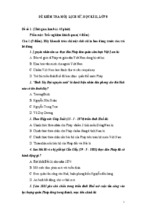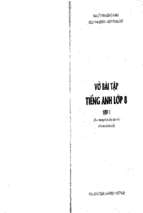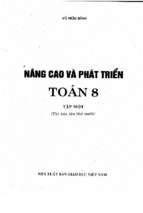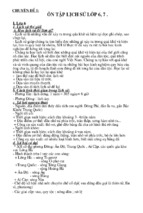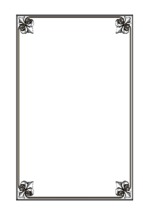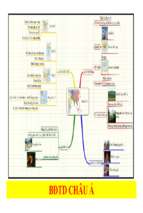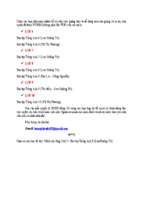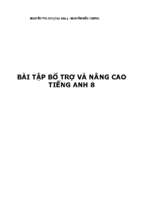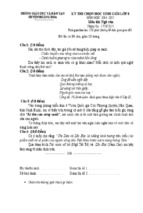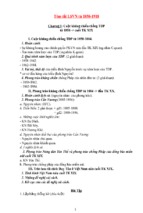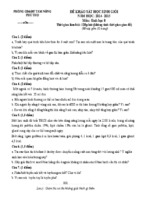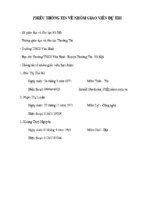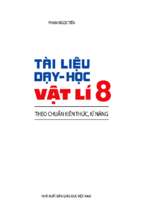Sách giáo viên tiếng anh 8 theo chương trình thí điểm tập 1
CONTENTS
Page
�,1752'8&7,21� ............................................................................................................................................................. III
�%22.�0$3 .................................................................................................................................................................................4
�81,7����/(,685(�$&7,9,7,(6� .....................................................................................................................8
�81,7����/,)(�,1�7+(�&28175<6,'(� ......................................................................................... 28
�81,7����3(23/(6�2)�9,(7�1$0� ...................................................................................................... 48
�5(9,(:���................................................................................................................................................................................. 68
�81,7����285�&867206�$1'�75$',7,216� .................................................................. 72
�81,7����)(67,9$/6�,1�9,(7�1$0� .................................................................................................. 92
�81,7����)2/.�7$/(6� ......................................................................................................................................... 112
�5(9,(:���.............................................................................................................................................................................. 132
INTRODUCTION
TIẾNG ANH 8 is the third of the four levels of English language textbooks for Vietnamese
students in lower secondary schools learning English as a foreign language (EFL). It follows
the systematic, cyclical, and theme-based syllabus approved by the Ministry of Education and
Training in January 2012, which focuses on the use of language (pronunciation, vocabulary,
and grammar) to develop the four language skills (listening, speaking, reading, and writing).
THE COMPONENTS OF THE TEXTBOOK
The complete learning set of TIẾNG ANH 8 consists of THE STUDENT’S BOOK, THE
TEACHER’S BOOK, THE WORKBOOK, and THE CD.
THE STUDENT’S BOOK
The Student’s Book contains:
•
Book map: Introducing the basics of each unit
•
12 topic-based Units, each covering seven sections to be taught in seven 45-minute lessons
•
Four Reviews, each providing revision and further practice of the previous three units,
to be dealt with in two periods
•
Glossary: Giving meaning and phonetic transcription of the new words in the units
THE TEACHER’S BOOK
The Teacher’s Book gives full procedural notes for teaching different parts of each unit.
The answer keys to the exercises in the Student’s Book and the transcriptions are also given in
the Teacher’s Book.
THE WORKBOOK
The Workbook mirrors and reinforces the content of the Student’s Book. It offers:
•
Further practice of the language and skills taught in class
•
Four additional tests for students’ self-assessment
THE CD
•
The CD provides recorded scripts of all listening exercises and dialogues
THE COMPONENTS OF EACH UNIT
There are 12 main units in the Student’s Book. Each unit has seven sections and provides
language input for seven classroom lessons of 45 minutes each. These 12 richly illustrated,
cross-curricular, and theme-based units focus on offering students motivation, memorable
lessons, and a joyful learning experience. At the beginning of each unit there are explicit
learning objectives that clearly state the main language and skills to be taught in the unit.
SECTION 1: GETTING STARTED
This section occupies two pages and is designed for one 45-minute lesson in class. It begins
with a conversation followed by activities which introduce the topic of the unit. It then
presents the vocabulary and the grammar items to be learnt and practised through the skills
and activities of the unit.
SECTION 2: A CLOSER LOOK 1
A Closer Look 1 and A Closer Look 2 are each designed to be taught in one 45-minute lesson.
INTRODUCTION
III
A Closer Look 1 presents and practises the vocabulary and pronunciation of the unit. The
active vocabulary of the unit is given in an interesting and illustrated way so that it is easy
for students to memorise. Two or three sounds, which frequently appear in the unit, are
targeted and practised in isolation and in context. There are different exercises focusing
on intensive practice of vocabulary and pronunciation.
A grammar item may also be included in this section.
SECTION 3: A CLOSER LOOK 2
This section deals with the main grammar point(s) of the unit. The new language points are
presented in a short text or a talk/interview. There are grammar tables and exercises which
are well illustrated to help students remember and use the grammar items effectively.
The ‘Remember’ boxes appear wherever necessary and help students to avoid common errors.
A Closer Look 1 and A Closer Look 2 cover three pages and mainly give language focus and
practice of receptive skills.
SECTION 4: COMMUNICATION
This section is designed to help students use the functional language in everyday life
contexts and to consolidate what they have learnt in the previous sections. It also gives
students opportunities to learn and apply the cultural aspects of the language learnt. The
communication section provides cultural information about Viet Nam and other countries in
the world. The vocabulary is clearly presented in boxes wherever it is needed.
SECTION 5: SKILLS 1
Skills 1 and Skills 2, each covers one page and is designed to be taught in one 45-minute lesson.
Skills 1 comprises reading (receptive skill) and speaking (productive skill).
5HDGLQJ
This section aims to develop students’ reading abilities. In order to make the activity
achievable, the reading text is often based on the vocabulary and structures that students
have previously acquired. The reading always links with the topic of the unit and is interesting
and relevant to the students. Important new vocabulary is introduced in the text and
practised in a follow-up activity.
The reading also provides input for the speaking that follows.
6SHDNLQJ�
This section aims to provide further practice which supports students in their production of
spoken English. The section uses the recently introduced items in combination with previously
learnt language in new contexts.
SECTION 6: SKILLS 2
Skills 2 is composed of listening (receptive skill) and writing (productive skill).
/LVWHQLQJ�
The listening section provides students with an opportunity to develop their listening skills.
This section trains them to listen for general and specific information.
:ULWLQJ
This section focuses on developing students’ writing skills. There is a writing tip or a guideline
which is very useful to help them to write effectively. The result of the writing section must
be a complete piece of writing (which is ideally assessed by the group/class/teacher).
SECTION 7: LOOKING BACK & PROJECT
This section covers two pages and should be dealt with in one 45-minute lesson.
Looking Back recycles the language from the previous sections and links it with unit topics.
Various activities and exercises are designed to help students consolidate and apply what
they have learnt in the unit. Through the students’ performance in this section, teachers can
evaluate their study results and provide further practice if necessary.
IV
INTRODUCTION
The Project helps students to improve their ability to work by themselves and in a team. It
extends their imagination in a field related to the unit topic. The teacher can use this as an
extra-curricular activity (for groupwork) or as homework for students to do individually.
REFERENCE FOR SKILLS AND LANGUAGE TEACHING
1. TEACHING READING
Reading is the first of the four language skills that receives special attention in Tiếng Anh 8.
-
The reading activities in Tiếng Anh 8 aim to help students develop sub-skills such as
skimming for gist and scanning for details.
-
Explanations should be given to students when they do not understand the meaning of
a word. Some reading strategies such as focusing on familiar words, guessing unfamiliar
words in context, etc. should be taught to students.
-
Before teaching the text, the teacher should encourage students to guess what the text is
about, what new words may appear in the text, etc.
2. TEACHING SPEAKING
There are two forms of speaking in Tiếng Anh 8: spoken interaction and spoken production.
The first refers to the ability to ask and answer questions and handle exchanges with others. The
second refers to students’ ability to produce language appropriately and correctly.
Speaking activities include:
-
Pronunciation: dialogues and role-plays (games, rhymes, and songs). Through these
forms, students practise the stress, rhythm, and intonation patterns of English in a
natural way. It is crucial to provide students with a lot of models and to build up their
confidence with acceptance of approximate correct pronunciation.
-
Repetition: helps students to memorise vocabulary and ‘chunks’ language. Repetition
and classroom routines build up an expanding repertoire of English that helps students
understand and respond to a situation as a part of communicative interactions in class.
One strategy is to provide a lot of opportunities for students to practise with a secure
feeling through choral repetition of action rhymes and games. It is also important to
establish classroom routines (such as greetings and saying goodbye) at the beginning and
the end of the lessons. Asking for permission, using common classroom expressions (e.g.
I don’t understand. Could you say it again, please? May I ask you a question?), or answering
a question (e.g. I don’t know. I think/guess..., Perhaps...) are important language tasks for
students to practise daily.
-
Pair work/group work and class presentations help students to talk freely in a language
situation related to the topic of the unit. They also make students feel secure and promote
their confidence in speaking.
Error correction should be done cautiously by the teacher. When students are talking, the
teacher should not stop them to correct their mistakes. Mistakes should be analysed and only
common errors should be highlighted afterwards and corrected collectively.
3. TEACHING LISTENING
Through listening, students become familiar with the sounds, rhythms, and intonation of
English. When listening to English, students are actively engaged in constructing meaning and
making sense of what they hear, using their knowledge and the clues provided by the context.
It is very important to teach students to be aware of the purpose, the content, and intonation
of the listening text.
INTRODUCTION
V
Before listening, teachers should motivate and engage students in the listening activity;
encourage them to predict the listening content; and introduce the new language or
vocabulary which occurs in the listening text.
The listening activities aim to help students understand spoken English and develop
sub-listening skills such as listening for gist and listening for details.
4. TEACHING WRITING
The writing activities aim to develop students’ basic writing skills in English. Its emphasis is on
providing writing techniques for a particular genre (e.g. email, an informal letter, a webpage, etc.)
as well as practising the spelling of familiar vocabulary and sentence patterns. Teaching writing
can be divided into three stages: before writing, while writing, and after writing.
-
Before writing helps students understand why they write and provides them with the
language input to express their ideas in English.
-
While writing helps students write independently under the teacher’s guidance and
supervision.
-
After writing helps students perfect their writing. They share their writing with peers and
teacher for comments. After that, they revise (i.e. re-reading the writing to improve the
content and organisation of ideas) and edit (i.e. re-reading the writing to correct errors
and mistakes in grammar, vocabulary, spelling, etc.) it. They then submit their writing to
the teacher for evaluation.
5. TEACHING PRONUNCIATION
In this book, the pronunciation part focuses on sentence stress and intonation. The students will
have chance to practise saying sentences with correct stress on content words. Also, they can
identify in which situations to stress pronouns, the verb ‘be’, auxiliaries, and short words and say
these sentences correctly. Besides, they will practise intonation patterns in English.
In teaching sentence stress and intonation, it is advisable that the teacher should engage the
students by using varied techniques including:
•
Visual aids (flashcards, pictures, etc.)
•
Miming
•
Syllable/word focus and repetition
•
Line by line repetition and clapping
•
Listening and marking the stressed words
•
Pair/group practice and performance
6. TEACHING VOCABULARY
Teaching vocabulary helps students understand, memorise, and use words appropriately in
their specific contexts. Students at lower secondary level still learn ‘chunks’ of English which
combine vocabulary and grammatical patterns in an unanalysed way. Therefore, it is crucial to
give students plenty of time to practise, memorise, recycle, and extend their vocabulary and
grammar in meaningful contexts. Regular recycling of vocabulary helps students recognise
the same words embedded in different contexts and activities again and again. When teaching
vocabulary, it is important to help students recognise, practise, and memorise words. This
can be done by using visual aids (e.g. pictures, flashcards), by allowing students to listen and
repeat the words, by explaining their meanings, using definitions and translation if necessary,
and finally, by getting students to practise using the words with a range of spoken or written
activities, which can be done individually or in pairs.
VI
INTRODUCTION
7. TEACHING GRAMMAR
Teaching grammar helps students use correct grammatical patterns to express their ideas in
specific contexts.
Grade 8 students of English already know some English grammar based on formulaic
sequences and a lot of grammar points met in the context of dialogues, readings, chants,
rhymes, stories, and songs they have learnt in primary schools, grade 6 and grade 7.
One way to raise students’ language awareness is drawing their attention to specific
language patterns or features of grammatical forms and, if necessary, comparing or contrasting
these with corresponding patterns and forms in Vietnamese. The appropriate techniques to be
used to teach students are:
-
Focusing students’ attention on the new grammatical patterns in the texts.
-
Providing models for students to practise the new grammatical item in a spoken or written
activity, using the cued pictures or prompts in their books.
-
Reinforcing the new grammatical item with a variety of spoken and written activities.
SEQUENCING
Students should be given clear instructions about what they are expected to do and say.
The following are some suggested teaching procedures.
-
Whole class. Elicit/Teach the focus language (words, phrases, or structures). Then write
them on the board.
-
Model. Perform the focused materials yourself with a confident student or ask a pair
to demonstrate in front of the class. Help and guide them to interact in a reasonably
structured manner. This will enable the freer stage of independent pair work/group work
that will follow.
-
Pairs/groups. Students practise in pairs or groups. Monitor the activity and offer help if
necessary.
-
Performance. Ask a confident pair or some volunteers to perform the task for the rest of
the class.
-
Whole class. At the end of the activity, there should be some writing/speaking (productive)
activities to reinforce or consolidate students’ understanding.
It is noted that all of the procedures written in this book are only suggestions.
Teachers may adapt these or design their own procedures to suit their students
and real teaching contexts.
INTRODUCTION VII
%22.�0$3
Reading
Listening
Unit 1:
Leisure activities
- Reading for general and
specific information about
the possible effects of
spending too much time on
the computer
- Listening for specific
information about ways of
spending time with friends
Unit 2:
Life in the
countryside
- Reading for specific
infomation about an unusual
lifestyle in the countryside:
Mongolian nomadic life
- Listening for specific
information about changes in
the countryside
Unit 3:
Peoples of Viet Nam
- Reading for specific
information about an ethnic
group
- Listening for specific
information about a
traditional speciality
Unit 4:
Our customs and
traditions
- Reading for specific
information about family
customs and traditions
- Listening for specific
information about a
traditional dance of an ethnic
group in Viet Nam
Unit 5:
Festivals in Viet Nam
- Reading for specific
information about two
festivals in Viet Nam
- Listening for general and
specific information about a
traditional festival
Unit 6:
Folk tales
- Reading for specific
information about a fairy tale
- Listening for specific
information about a fairy tale
REVIEW 1
REVIEW 2
4
BOOK MAP
Speaking
Writing
Language Focus
- Talking about ‘good’
and ‘bad’ sides of leisure
activities
- Writing to discuss an
opinion about leisure
activities
- Verbs of liking + gerunds
- Verbs of liking + to-infinitives
- Clusters: /br/ and /pr/
- Talking about what you
like or dislike about life in
the countryside
- Writing about changes in
the countryside.
- Comparative forms of adjectives: review
- Comparative forms of adverbs
- Clusters: /bl/ and /cl/
- Talking about life of an
ethnic group
- Writing about how to cook
a traditional dish
- Questions: review
- Articles (some uses)
- Clusters: /sk/, /sp/ and /st/
- Talking about family
customs and traditions
- Writing about a
traditional dance
- Should and shouldn’t: review
- have to
- Clusters: /spr/, /str/
- Talking about the
reasons for going to a
festival and the things to
take when attending a
festival
- Writing about a festival
- Simple sentences and compound
sentences: review
- Complex sentences
- Stress of words ending in –ion and –ian
- Talking about a legend/
folk tale/ fairy tale/ fable
- Narrating a legend/ folk
tale/ fairy tale/ fable
- Past simple: review
- Past continuous
- Intonation in exclamatory sentences
BOOK MAP
5
8QLW
/(,6
/(,685(�$&7,9,7,(6
6
THIS UNIT INCLUDES:
*(77,1*�67$57('
VOCABULARY
,WuV�ULJKW�XS�P\�VWUHHW�
PRONUNCIATION
Leisure activities
Clusters: /br/ and /pr/
GRAMMAR
Verbs of liking + gerunds
Verbs of liking + to-infinitives
COMMUNICATION
Talking about leisure activities
Organising your ideas
�
Listen and read.
Mai: Check out this book, Phuc. ‘My Mini Guide
to Dog Training’.
Nick: Ha ha, not sure about that. But I think I’ll enjoy
listening to the melodies.
Phuc: Sounds great! Max’ll like it too. Last weekend
we learnt some tricks. I love to watch him. It’s so
much fun… Have you found your craft kit?
Phuc: Look at the language website I sent you. It’ll
help you learn Vietnamese more easily.
Mai: Yes, I’ve found this one. It’s got everything:
beads, stickers, wool, buttons… I don’t
know, it’ll take all my savings.
Phuc: But it’s right up your street! Nick, what’s that?
Nick: It’s a CD of Vietnamese folk songs. I’ll listen
to it tonight.
Mai: And you’ll be able to improve your Vietnamese!
6
Unit 1/ Leisure Activities
Nick: Yes, I liked reading Doraemon comics while
I was learning Japanese.
Phuc: Stop reading comics! I’ll bring you my
favourite short story this Sunday when we
play football.
Mai: Sorry but we have to hurry. Mum and dad
are waiting. We need to buy some tools to
build a new house for Max this weekend.
2EMHFWLYHV�
By the end of this unit, students can:
•
pronounce words containing the clusters /br/ and /pr/ correctly in isolation and in
context
•
•
•
•
use the lexical items related to the topic of leisure activities
•
•
•
use verbs of liking that are followed by gerunds
use verbs of liking that are followed by to-infinitives
read for general and specific information about the positive and negative effects of
using computers
talk about ‘good’ and ‘bad’ sides of leisure activities
listen for specific information about ways of spending time with friends
write to discuss an opinion about leisure activities
*(77,1*�67$57('����
,WuV�ULJKW�XS�P\�VWUHHW�
,QWURGXFWLRQ
Prepare photos or magazine cut-outs about some popular leisure activities
including those you often do in your spare time. Ask Ss to describe them in English.
Then ask them to guess which activities you enjoy doing. Encourage Ss to do the
same in pairs: One student writes a short list of activities and the other guesses.
�� Ask Ss to open their books to the picture. Introduce Mai, Phuc, and Nick. Ask Ss to guess
where they are and what they are doing. For more able classes, brainstorm questions
with Ss and write them on the board. Questions may include:
What can you see in the picture?
Why do you think Mai, Phuc, and Nick are there?
What are they holding in their hands?
What are they talking about?
Can you guess what Mai, Phuc, and Nick like doing in their free time?
etc.
Accept all possible answers from Ss and do not provide correction at this stage. Play
the recording and have Ss follow along. Then come back to the earlier questions and
have Ss answer them. Again, do not give correction at this stage.
Unit 1/ Leisure Activities
6T
D
�� Find words/ phrases in the box to describe the
Circle the correct answer.
photos. Then listen to check your answers.
1. Phuc, Mai, and Nick are in a library/ bookstore/
sports club.
2. Phuc is looking for a book/ dog/ craft kit.
3. Max is Phuc’s cat/ goldfish/ dog.
4. Mai has found a book/ CD/ craft kit for herself.
5. Nick’s CD is of folk music/ pop music/ rock music.
6. Nick is trying to learn Vietnamese/ Japanese/
English.
playing beach games
playing football
making crafts
playing computer games
texting
visiting museums
doing DIY
E� Which leisure activities do you think Phuc,
Mai, and Nick have? Tick ( ) the boxes. Then
find the information from the conversation
to explain your choice.
Phuc
Mai
1. _____________
2. _____________ 3. _____________
4. _____________
5. _____________ 6. _____________
Nick
1. pet training
2. making crafts
3. reading
4. listening to music
5. learning languages
6. playing sports
7. helping parents
with DIY projects
Learning tip
DIY: Do It Yourself: Work on the house that
you do yourself without the help of experts,
e.g. painting a room, fixing the garden fence,
building a dog house, etc.
F
Answer the questions.
�
Complete the following sentences with the
words in the box. In some cases, more than
one answer can be relevant.
good
satisfied
relaxing
exciting
fun
boring
1. You do leisure activities in your free time and they
make you feel _______________.
2. You can do _______________ activities such as yoga,
or _______________ ones such as mountain biking or
skateboarding.
3. Hobbies such as making crafts or collecting things
are _______________.
4. You can surf the Internet but some people say this
is _______________.
1. What does Mai mean when she says ‘Check out
this book’?
5. You can spend time with family and friends, or
become a volunteer for the community. This will
make you feel _______________.
2. What does Phuc mean when he says ‘It’s right up
your street!’?
�� *$0(�
&+$1*,1*�3$571(56
Choose one leisure activity from � or �.
In pairs, talk about it. Try to keep going for
one minute each. When the time is up, find a
new partner and talk about another activity.
You may:
describe the leisure activity
say if you have done this activity or not
share your feelings about the activity
7
Unit 1/ Leisure Activities
D
Ss work individually to circle the correct answer. Ss compare their answers with a partner and then discuss
as a class. T goes through each statement and asks Ss how the text and the visual in the dialogue support
their answers. After the discussion, T writes the correct answers on the board.
Key: 1. bookstore
4. craft kit
2. book
5. folk music
3. dog
6. Vietnamese
E� Go through the list of activities mentioned. Encourage Ss to explain what they are and to give examples.
Ask Ss if they have done any of these activities, or if they know anyone who does these in their free time.
Have Ss do this task individually first, then compare the answers with their partner. They should be able to
give ideas from the text that support their answers.
Key:
Phuc
Mai
Nick
1. pet training
2. making crafts
3. reading
4. listening to music
5. learning languages
6. playing sports
7. helping parents with DIY projects
F
Draw Ss’ attention to the contexts when Mai said ‘Check out this book’ and Phuc said ‘It’s right up your
street!’. Together with Ss elicit the meaning of these two expressions.
To check out something means to examine something or get more information about it in order to be
certain that it is suitable (or true, or safe).
If something is right up your street, it is the type of thing that you are interested in or that you enjoy doing.
Ask Ss for examples of something they can check out, and something which is right up their street. For a
more able class, ask Ss to make a 2-turn dialogue in which they use these expressions.
�
Ss work in pairs to match the words/ phrases in the box to the photos, then they listen together to check
their answers.
Key: 1. playing computer games
4. texting
2. playing beach games
5. visiting museums
3. doing DIY
6. making crafts
If time allows, ask Ss to use adjectives to say what they think of these activities, eg. exciting, interesting, etc.
�� Ss work individually to do the task then compare their answers with a partner. Tell Ss they need to look for
the surrounding keywords in order to complete the task. Note that ‘good’ and ‘satisfied’ fit both items 1
and 5. Acknowledge this point with Ss who have them the other way round.
Key: 1. satisfied
�
2. relaxing, exciting
3. fun
4. boring
5. good
Game: Changing partners
This game can be done in groups of four or six, or as a mingle activity.
If your classroom is large enough, ask Ss to stand in two lines facing each other. Each pair will talk about
one activity for one minute. When the time is up and T calls out ‘Change!’, they will move one step to the
left/right to meet a new partner and talk about another activity.
Unit 1/ Leisure Activities
7T
$�&/26(5�/22.��
Vocabulary
�
Look at the following pie chart on leisure activities in the US and answer the questions.
Leisure time on an average day
Relaxing and thinking
(17 minutes)
Other leisure activities
(18 minutes)
Using the computer
for leisure
(25 minutes)
Watching TV
(2.8 hours)
Doing sports
and exercise
(19 minutes)
Reading
(20 minutes)
Socialising and
communicating
(39 minutes)
TOTAL LEISURE AND
SPORTS TIME = 5.1 HOURS
NOTE: Data include all persons aged 15 and over. Data includes all days of the week and are annual averages for 2012
SOURCE: Bureau of Labor Statistics, American Time Use Survey
1. How much leisure time did people in the US
have on an average day in 2012?
�
2. What did they do in their leisure time?
1.
2.
3.
4.
5.
6.
7.
8.
3. What were the three most common activities?
�� Complete the table with information from the
a. Learning something interesting
pie chart.
Name of activity
relaxing
Look at the words. Match them to the category
labels.
skateboarding, football, badminton
a novel, poetry, a magazine
the news, a reality show, a comedy
a new language, a skill
collecting stamps, making origami
going to local performances, visiting museums
visiting relatives, going shopping, doing DIY
texting, going to the cinema, hanging out
b. Reading
Verb
c. Spending time with family
d. Having hobbies
relax
f. Watching TV
e. Playing sports
g. Socialising with friends
h. Going to cultural events/ places
Now add more words to each category.
�
8
Unit 1/ Leisure Activities
How much time do you spend a day on leisure
activities? What are the three activities that you
do the most? Share your ideas with a partner.
$�&/26(5�/22.��
,QWURGXFWLRQ
Before starting the lesson explain what a ‘pie chart’ is and how
each slice can be calculated as a percentage of the whole. Give Ss
some simple statistics and make a pie chart with them as a class.
9RFDEXODU\
�� Ask Ss to work in pairs to examine the pie chart closely in order to understand its contents, including the
-
heading, subheadings, figures, colour codes, source, and notes. Allow enough time for this step. Do not
give correction. Then ask Ss to answer the questions that follow the chart.
If necessary, T may elicit information by asking questions such as:
What is the pie chart about? Where can you find the information?
What do the different coloured sections of the chart refer to?
How are these sections calculated?
What does the ‘Note’ tell you?
What does the ‘Source’ tell you?
Key:
1. In 2012, people in the US spent 5.1 hours a day on sports and leisure activities.
2. The main activities they did include watching TV, socialising and communicating, reading, participating
in sports and exercise, using computers for leisure, relaxing and thinking.
3. The three most common activities were watching TV, socialising and communicating, and using
computers for leisure.
�� Have Ss work individually to complete the task. After giving corrective feedback, draw their attention to
the part of speech of the words mentioned (e.g. relaxing comes from the verb relax with –ing added, and it
refers to the activity).
Then introduce the concept of gerund (a noun made from a verb by adding -ing). Give Ss some examples
where a gerund is transformed from a verb and used as a noun. For a more able class, ask Ss to make their
own sentences.
Key:
Name of activity
relaxing
thinking
using
doing
watching
reading
socialising
communicating
Verb
relax
think
use
do
watch
read
socialise
communicate
�� For a more able class, ask Ss to cover the category labels. Have Ss look at the words and try to guess what
these words have in common. T may elicit answers from Ss by asking questions, for example:
What is the common verb we often use with these? How can we use this verb to describe the activity?
Who do we often do these with? Where do we often do these? etc.
Do not give correction at this step. Ask Ss to work in pairs to complete the task. Once they have finished
and T has given corrective feedback, encourage them to add more words in each category.
Key: 1. e
2. b
3. f
4. a
5. d
6. h
7. c
8. g
�� Have Ss work in small groups. Allow them enough time to think about what their average day may look
like (including study and work) and how much time is spent on leisure activities. If there is plenty of time,
encourage them to calculate these times as percentages and put them in a simple pie chart similar to �.
Alternatively, this task can be done as a mingle activity. Have Ss write down how much time they spend
on leisure activities on an average day, and the three activities they do the most. Ss move around and
talk with at least three other classmates to find out who spends most time on leisure and what the most
popular activities in the class are.
Unit 1/ Leisure Activities
8T
$�&/26(5�/22.��
Pronunciation
Clusters: /br/ and /pr/
Grammar
�� Complete the words under the pictures with
Verbs of liking + gerunds
Verbs of liking + to-infinitives
/br/ or /pr/. Listen to check your answers and
repeat.
If we want to follow a verb with
another action, we must use a
gerund or an infinitive.
�
1. a ____icot
2. ___ridge
Read the conversation in Getting Started
again. Underline verbs that are followed by
a gerund.
Look out!
3. _____acelet
The verbs love, like, hate, and prefer
can be used with both gerunds and
to-infinitives without much change
e
in meaning.
She loves going out with her friends.
= She loves to go out with her friends.
4. ______ead
Learning tip
5. ______incess
Verbs of liking
adore
love
cy
like, enjoy, fan
d
in
m
don’t
e
dislike, don’t lik
hate
detest
6. _____esident
�
7. _______esent
�
Tick ( ) the appropriate box. Then listen to
check.
followed by followed by both gerund
gerund only and to-infinitive
8. ________occoli
Listen and repeat.
1. She loves making apricot jam.
1. love
2. enjoy
2. My dad likes making bread in his free time.
3. Hien is our club president.
3. detest
4. Mai keeps all her bracelets in a beautiful box.
5. You will need a brush if you want to paint
your room.
6. This is a wonderful present. Thanks so much!
9
Unit 1/ Leisure Activities
Degree
4. prefer
5. fancy
3URQXQFLDWLRQ
Clusters: /br/ and /pr/
� Have Ss work individually to complete this task. Once they have finished, Ss work in pairs to compare their
answers. Play the recording for Ss to check and then repeat. Pause the recording to drill difficult items.
Audio script:
1. apricot
5. princess
2. bridge
6. president
3. bracelet
7. present
4. bread
8. broccoli
Ask Ss to add more words which contain these clusters. For a more able class, Ss may make sentences with
these words and practise saying them.
�
Have Ss practise the words with the clusters first. Then ask them to repeat the whole sentence. If time allows,
ask Ss to cover their books and listen to the recording. If they hear the word with cluster /pr/ they have to
raise up their left hand, if it is cluster /br/ they raise up their right hand.
Audio script:
1. She loves making apricot jam.
1
2. My dad likes making bread in his free time.
3. Hien is our club president.
4. Mai keeps all her bracelets in a beautiful box.
5. You will need a brush if you want to paint your room.
6. This is a wonderful present. Thanks so much!
$�&/26(5�/22.��
Grammar
Verbs of liking + gerunds, Verbs of liking + to-infinitives
�� Remind Ss of the concept of the gerund from A CLOSER LOOK 1. Ask them how the gerund is formed and
how it functions grammatically. Draw Ss’ attention to ‘love to watch’ and ‘enjoy listening’ which appear in
the text in GETTING STARTED:
- I love to watch him …
- But I think I’ll enjoy listening …
Explain that in English if we want to follow a verb with another action, we must use a gerund or an infinitive.
There are certain verbs that can only be followed by one or the other, and these verbs must be memorised.
Read or play the recording in GETTING STARTED for Ss to listen and ask them to underline the verbs of liking
followed by gerunds or to-infinitives that they find in the text. For a more able class, T may ask Ss to cover
the text and just listen to identify these verbs.
Key: love (to watch)
�
enjoy (listening)
liked (reading)
Go through the Look out! box with Ss. Tell Ss that verbs of liking/disliking are often followed by gerunds,
but verbs such as love, like, hate, start and prefer may go with gerunds or to-infinitives with almost no
change in meaning.
Give some examples for both cases. Encourage Ss to give their own examples.
Introduce Ss to the Learning tip box, where they can differentiate the difference in terms of degree these
verbs of liking/disliking. Alternatively, T may write these verbs on the board with a really happy smiley face at
the top of the board and a really unhappy smiley face at the bottom and then ask Ss to rearrange them in
a particular order without looking at the Learning tip box.
Ss work individually and then compare the answers with their partners.
Key:
followed by gerund only
followed by both gerund and to -infinitive
1. love
2. enjoy
3. detest
4. prefer
5. fancy
1.
2.
3.
4.
5.
Audio script:
I love eating spicy food.
I love to eat spicy food.
Jane enjoys running.
Phong detests doing DIY.
I prefer reading poetry.
I prefer to read poetry.
Do you fancy watching TV?
Then play the recording for Ss to check their answers.
Unit 1/ Leisure Activities
9T
�� Write the correct form of the verbs.
�
Look at the following email that Minh Duc
wrote to a new penfriend.
Hi, my name’s Duc.
How are you? This is what I like
do in my free time. I often play
video games or watch TV. Or I
go to the park and play football
with my friends. I enjoy do this
very much! I sometimes help my
parents too. If I have homework,
I’ll try to finish it first before I
do anything else. But I don’t
like have lots of homework !
I don’t mind to do homework
but I hate spend all evening on
it! On Saturday or Sunday, I love
eat out with my family. The food
is delicious!
What about you??
Best,
Duc
1. Mai enjoys ____________________ (make) crafts,
especially bracelets.
2. People in Britain love _______________ (watch) TV
in their free time.
3. Do you fancy _______________ (skateboard) in the
park this Sunday?
4. Nick likes ________________ (learn) Vietnamese.
D
There are six grammar mistakes in his email.
Can you find and correct them?
E
Answer the questions.
5. Ngoc hates ___________________ (sit) at the
computer for too long.
�
Write sentences about what you like or don’t
like doing in your free time, beginning with
the following. Then share what you have
written with your partner.
1. I adore ______________________________________.
2. I love ________________________________________.
3. I fancy ______________________________________.
4. I don’t mind_________________________________.
5. I don’t like __________________________________.
6. I detest ______________________________________.
10
Unit 1/ Leisure Activities
1. How many activities does Duc mention in his
email?
2. Which two activities do you think he enjoys the
most?
�
Write a similar email to tell your friend about
your free time, using the verbs of liking +
gerunds or verbs of liking + to-infinitives.
Swap your work with a partner and check for
mistakes.
�� Ss work in pairs to complete this task, then T gives feedback to Ss as a class.
Key:
1. making
2. to watch/watching
4. to learn/learning
5. sitting
3. skateboarding
�� This task can be done in groups of five or six. Give Ss time to work individually at first and write each
sentence on a strip of paper, then in their group mix up the strips. Each student picks up and reads out a
sentence, then they guess who wrote that sentence.
�
Have Ss quickly familiarise themselves with the email by asking: Who wrote this email? To whom? What is it
about? Have Ss scan the email to find the answers.
D
Ss work individually and compare their answers with a classmate.
Key:
Hi, my name’s Duc.
How are you? This is what I like do in my free time. I often play video games or watch TV. Or I go to the park
and play football with my friends. I enjoy do this very much! I sometimes help my parents too. If I have
homework, I’ll try to finish it first before I do anything else. But I don’t like have lots of homework ! I don’t
mind to do homework but I hate spend all evening on it! On Saturday or Sunday, I love eat out with my
family. The food is delicious!
What about you?
Best,
Duc
like do → like to do/ like doing
enjoy do → enjoy doing
don’t like have → don’t like to have/don’t like having
don’t mind to do → don’t mind doing
hate spend → hate to spend/ hate spending
love eat out → love to eat out/ love eating out
E
Ask Ss to read the email again and answer the questions.
Key:
�
•
The activities Duc mentions in his email are: playing video games, watching TV, going to the
park, playing football, helping his parents, doing homework, and eating out with his family.
•
The two activities he enjoys the most are playing football with his friends, and eating out with
his family.
Ss work individually to write the email then exchange it with their partners and check for mistakes.
If there is time, have them ask and answer about the emails afterwards , using the questions in �E as a
guide. If there is not enough time, this task can be done as a group-writing task.
Unit 1/ Leisure Activities 10T
&20081,&$7,21
�
Extra vocabulary
window shopping
to be hooked on something
to sound weird
to be addicted to something
Read the following article on the magazine 4Teen website.
This week 4Teen has opened a forum for friends around
the world to share how they spend their free time.
I love hanging out w/ my best friend Helen in my spare time, like going
‘window shopping’. J4F! We also work as volunteers for an animal
protection organisation. 2moro we r going to a farm.
posted Tue 3.20 pm
HanVgiet Nam)
t,
(Phan Thie
Emily
(Perth, Au
stralia)
This may sound weird, but I adore cloud watching. Find an open space,
lie on ur back, n’ look at the clouds. Use ur imagination. EZ! DYLI too?
posted Wed 8.04 pm
This year my city is the European Capital of Culture, so lots goin’
on. At weekends my bro n’I go 2 our city community centre where
we dance, paint, and do drama. I’m hooked on drama! <3 it!
posted Thu 6.26 pm
Linn
(Umeå, Swed
en)
I like doing sports – I’m in my school’s football team. But
what I mostly do in my free time is help my aunt. She has
cooking classes 4 small groups of tourists. It’s WF 4 me!
posted Fri 7.19 pm
Minh
(Sa Pa, Viet Na
m)
I’ve been kind of addicted to the net. I just love sitting in
front of my computer for hours! But now my mum has said
it’s NUFF! I’ll start my judo class this weekend. It’s OK. WBU?
posted Fri 8.45 pm
Mairnes,uArgeelntina)
A
(Buenos
�
Can you understand the abbreviations in the
text? Use this ‘netlingo’ dictionary if necessary.
2moro
4
<3
bro
DYLI
EZ
J4F
goin’
n’
NUFF
r
ur
w/
WBU
WF
tomorrow
for
love
brother
Do you love it?
easy
just for fun
going
and
enough
are
your
with
What about you?
way fun
Now add to the dictionary other abbreviations
used for online chatting/texting that you know.
11
Unit 1/ Leisure Activities
�
Find information in the text to complete
the table.
Who?
What activity is
mentioned?
What does he/
she think of it?
Emily
�� Work with your partner and put the activities
in � in order from the most interesting to the
most boring. Then compare your ideas with
other pairs.
- Xem thêm -

